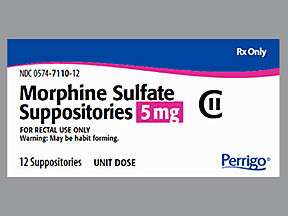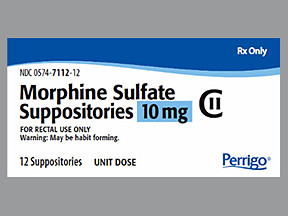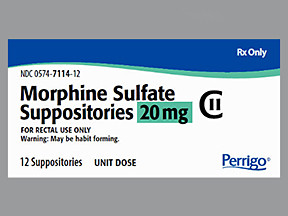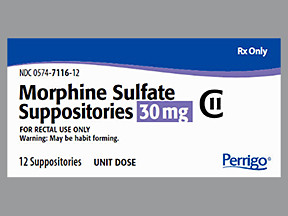MORPHINE SUPPOSITORY - RECTAL
PHONETIC PRONUNCIATION: (MORE-feen)
COMMON BRAND NAME(S): Roxanol
GENERIC NAME(S): morphine sulfate
Uses
USES: This medication is used to treat moderate-to-severe pain. It acts on certain centers in the brain to give you pain relief. This medication is an opioid (narcotic) analgesic.
How to use MORPHINE SUPPOSITORY - RECTAL
HOW TO USE: Unwrap and insert one suppository rectally as directed by your doctor. Lie down on your left side with right knee bent. Gently push the suppository into the rectum with your finger. Remain lying down for a few minutes, and avoid having a bowel movement for an hour or longer so the drug will be absorbed. The suppository is for rectal use only. The dosage is based on your medical condition and response to therapy. Pain medications work best if they are used as the first signs of pain occur. If you wait until the pain has worsened, the medication may not work as well. You may also take long-acting opioid medications or use opioid patches for ongoing pain if so directed by your doctor. In that case, this medication might be used for sudden (breakthrough) pain only as needed. Also follow your doctor's or pharmacist's instructions for safely using other pain relievers (such as naproxen, ibuprofen). Ask your doctor or pharmacist about using morphine safely with other drugs. This medication may cause withdrawal reactions, especially if it has been used regularly for a long time or in high doses. In such cases, withdrawal symptoms (such as restlessness, irritability, watery eyes, runny nose, sweating, diarrhea) may occur if you suddenly stop using this medication. To prevent withdrawal reactions, your doctor may reduce your dose gradually. Consult your doctor or pharmacist for more details, and report any withdrawal reactions right away. Though it helps many people, this medication may sometimes cause addiction. This risk may be higher if you have a substance use disorder (such as overuse of or addiction to drugs/alcohol). Use this medication exactly as prescribed to lower the risk of addiction. Ask your doctor or pharmacist for more details. When used for an extended period, this medication may not work as well and may require different dosing. Talk with your doctor if this medication stops working well. Inform your doctor if your pain persists or worsens.
Side Effects
Precautions
Interactions
Overdose
Images
Reviews
Faq for MORPHINE SUPPOSITORY - RECTAL
A morphine suppository is a medication that contains morphine, a strong opioid pain reliever, in a solid form. It is designed to be inserted into the rectum for the treatment of severe pain.
When inserted into the rectum, the morphine suppository dissolves and gets absorbed into the bloodstream. Morphine acts on certain receptors in the brain and spinal cord to block pain signals and provide pain relief.
Morphine suppositories are typically used for severe pain management in situations such as post-surgery recovery, cancer-related pain, end-of-life care, or when oral administration of pain medication is not feasible.
Morphine suppositories are known to be highly effective in providing relief from severe pain. However, the effectiveness may vary depending on individual factors such as the severity of the pain and the person's tolerance to opioids.
The onset of action for a morphine suppository is generally within 15 to 60 minutes after insertion. However, the exact onset time may differ depending on factors such as the individual's metabolism and the specific formulation of the suppository.
Common side effects of morphine suppositories include drowsiness, constipation, nausea, vomiting, dizziness, and itching. It is important to consult a healthcare professional if these side effects become severe or persistent.
Morphine suppositories should be used with caution in individuals with respiratory conditions, liver or kidney problems, history of substance abuse, or those taking sedatives. It is crucial to discuss any existing medical conditions or medications with a healthcare professional before using morphine suppositories.
Morphine suppositories are generally not recommended for use in children unless prescribed by a pediatrician. The dosing and safety considerations may vary depending on the child's age, condition, and medical history.
Morphine suppositories should be stored in a cool, dry place, away from direct sunlight and moisture. It is essential to follow the storage instructions provided on the packaging or as advised by a pharmacist.
Warning
WARNING: Morphine has a risk for abuse and addiction, which can lead to overdose and death. Morphine may also cause severe, possibly fatal, breathing problems. To lower your risk, your doctor should have you use the smallest dose of morphine that works, and use it for the shortest possible time. See also How to Use section for more information about addiction. The risk for severe breathing problems is higher when you start this medication and after a dose increase, or if you use the wrong dose/strength. Using this medication with alcohol or other drugs that can cause drowsiness or breathing problems may cause very serious side effects, including death. Be sure you know how to use morphine and what other drugs you should avoid taking with it. See also Drug Interactions section. Get medical help right away if any of these very serious side effects occur: slow/shallow breathing, unusual lightheadedness, severe drowsiness/dizziness, difficulty waking up. Keep this medicine in a safe place to prevent theft, misuse, or abuse. If someone accidentally swallows or uses this drug, get medical help right away. Before using this medication, women of childbearing age should talk with their doctor(s) about the risks and benefits. Tell your doctor if you are pregnant or if you plan to become pregnant. During pregnancy, this medication should be used only when clearly needed. It may slightly increase the risk of birth defects if used during the first two months of pregnancy. Also, using it for a long time or in high doses near the expected delivery date may harm the unborn baby. To lessen the risk, use the smallest effective dose for the shortest possible time. Babies born to mothers who use this drug for a long time may develop severe (possibly fatal) withdrawal symptoms. Tell the doctor right away if you notice any symptoms in your newborn baby such as crying that doesn't stop, slow/shallow breathing, irritability, shaking, vomiting, diarrhea, poor feeding, or difficulty gaining weight.
Disclaimer
IMPORTANT: HOW TO USE THIS INFORMATION: This is a summary and does NOT have all possible information about this product. This information does not assure that this product is safe, effective, or appropriate for you. This information is not individual medical advice and does not substitute for the advice of your health care professional. Always ask your health care professional for complete information about this product and your specific health needs.




No Reviews Yet